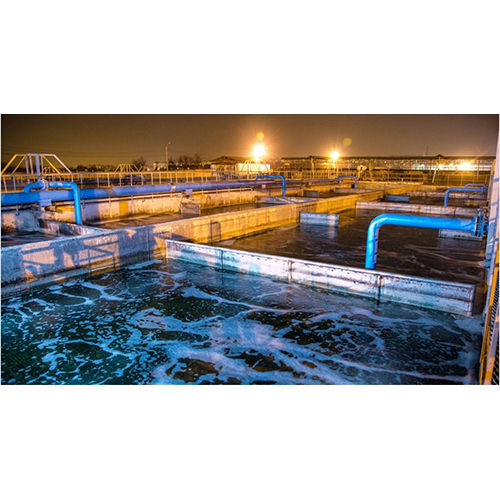Effluent Treatment Plant
124000 INR/Unit
Product Details:
- Membrane Size Standard
- Material Mild Steel
- Application Industrial
- Product Type Effluent Treatment Plants
- Power Source Electric
- Operation Type Automatic
- Click to View more
X
Effluent Treatment Plant Price And Quantity
- 1 Unit
- 124000 INR/Unit
Effluent Treatment Plant Product Specifications
- Mild Steel
- Standard
- Automatic
- Industrial
- Effluent Treatment Plants
- Electric
Effluent Treatment Plant Trade Information
- 30-45 Days
Product Description
An Effluent Treatment Plant (ETP) is a facility designed to treat wastewater from various industrial processes to ensure that it meets environmental standards before being discharged into the environment or reused. The treatment process typically involves several stages, each targeting different types of contaminants. Here is an overview of the main components and processes involved in an ETP:
1. Preliminary Treatment
This initial stage removes large solids and debris that could interfere with subsequent treatment processes.
- Screening: Removes large objects such as sticks, rags, and plastics.
- Grit Removal: Removes sand, gravel, and other heavy particles that can damage equipment.
2. Primary Treatment
Aims to settle out suspended solids and reduce the organic load in the effluent.
- Sedimentation Tanks: Allow heavy solids to settle at the bottom while oils and lighter solids float to the top.
- Primary Clarifiers: Separate suspended solids from the liquid effluent through sedimentation.
3. Secondary Treatment
Focuses on biologically degrading the organic matter present in the effluent.
- Aeration Tanks: Microorganisms are used to consume organic pollutants in the presence of oxygen.
- Activated Sludge Process: Involves aerating the effluent to promote the growth of aerobic bacteria that decompose organic material.
- Secondary Clarifiers: Further separate biological sludge from treated effluent.
4. Tertiary Treatment
Provides additional purification to meet higher water quality standards.
- Filtration: Removes remaining suspended particles.
- Disinfection: Kills pathogenic microorganisms using chlorine, UV light, or ozone.
- Advanced Treatments: Processes such as activated carbon adsorption, membrane filtration, and ion exchange to remove specific contaminants like heavy metals, nutrients (nitrogen and phosphorus), and trace organic compounds.
5. Sludge Treatment
Handles the sludge generated during the treatment process.
- Thickening: Increases the solid content of the sludge.
- Digestion: Breaks down organic material in the sludge anaerobically or aerobically, reducing volume and producing biogas.
- Dewatering: Further reduces the water content of the sludge, making it easier to handle and dispose of.
- Disposal: Treated sludge can be used as fertilizer, incinerated, or sent to a landfill.
6. Effluent Discharge and Reuse
After treatment, the clean effluent can be:
- Discharged: Released into water bodies like rivers, lakes, or oceans, complying with environmental regulations.
- Reused: Employed for non-potable purposes such as irrigation, industrial processes, or cooling systems.
Key Considerations in ETP Design and Operation
- Regulatory Compliance: Ensuring that the treated effluent meets local, national, and international standards.
- Cost Efficiency: Balancing the costs of construction, operation, and maintenance with the benefits of effective treatment.
- Technological Selection: Choosing appropriate technologies based on the type and volume of effluent, as well as specific contaminants present.
- Environmental Impact: Minimizing negative impacts on the environment and human health through effective treatment and disposal practices.
- Sustainability: Incorporating practices such as energy recovery, water recycling, and resource recovery to enhance sustainability.
Applications of ETPs
ETPs are used across various industries, including:
- Textile and Dyeing: Treating effluent containing dyes, chemicals, and heavy metals.
- Pharmaceutical: Handling complex chemical waste streams.
- Chemical Manufacturing: Managing diverse chemical pollutants.
- Food and Beverage: Treating organic waste and contaminants from production processes.
- Petroleum and Petrochemicals: Addressing hydrocarbons and chemical pollutants.
Effluent Treatment Plants play a crucial role in protecting water resources and the environment by ensuring that industrial wastewater is treated to acceptable standards before being discharged or reused.
FAQs of Effluent Treatment Plant:
Q: What is the membrane size of the Effluent Treatment Plant?
A: The membrane size of the Effluent Treatment Plant is standard.Q: What is the power source for the Effluent Treatment Plant?
A: The power source for the Effluent Treatment Plant is electric.Q: What is the application of the Effluent Treatment Plant?
A: The application of the Effluent Treatment Plant is industrial.Q: What is the material used for the Effluent Treatment Plant?
A: The material used for the Effluent Treatment Plant is mild steel.Q: What is the operation type of the Effluent Treatment Plant?
A: The operation type of the Effluent Treatment Plant is automatic.Tell us about your requirement

Price:
Quantity
Select Unit
- 50
- 100
- 200
- 250
- 500
- 1000+
Additional detail
Mobile number
Email
 English
English Spanish
Spanish French
French German
German Italian
Italian Chinese (Simplified)
Chinese (Simplified) Japanese
Japanese Korean
Korean Arabic
Arabic Portuguese
Portuguese







